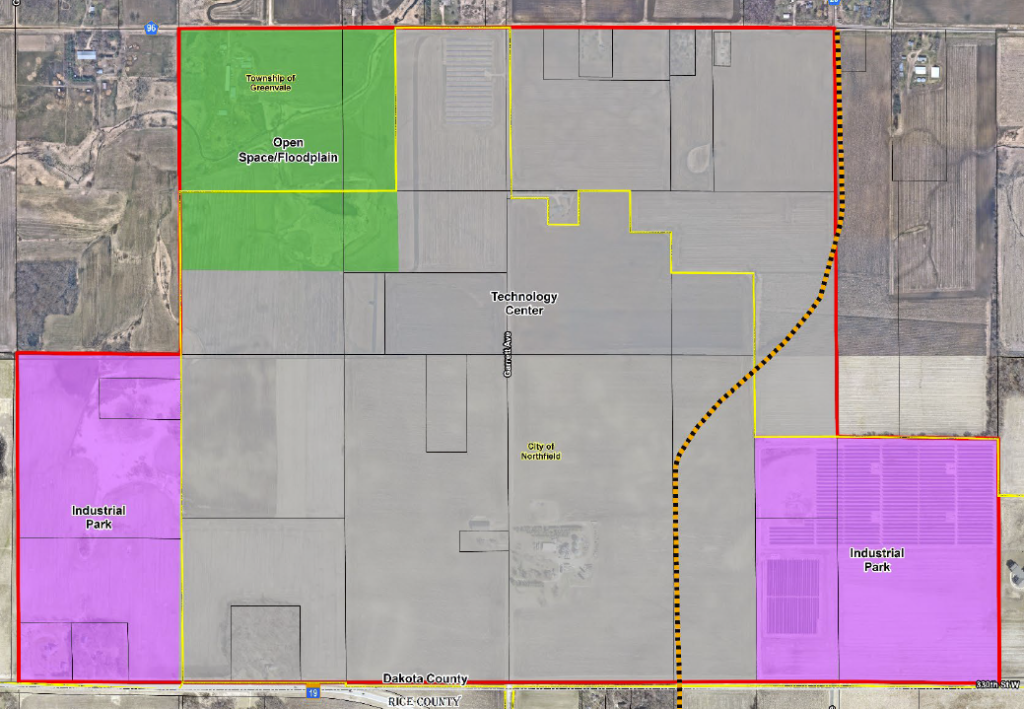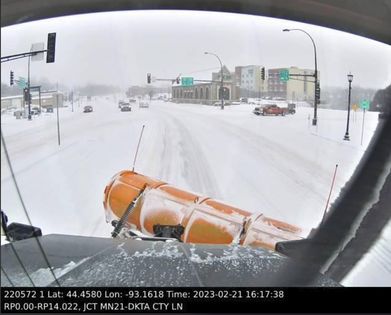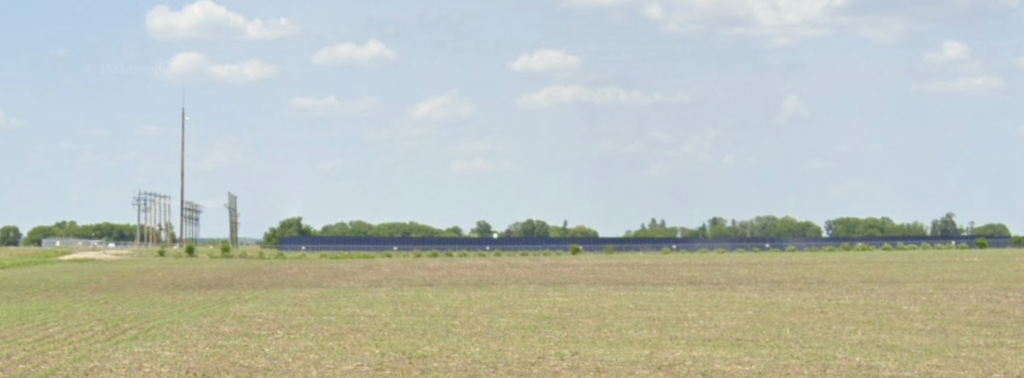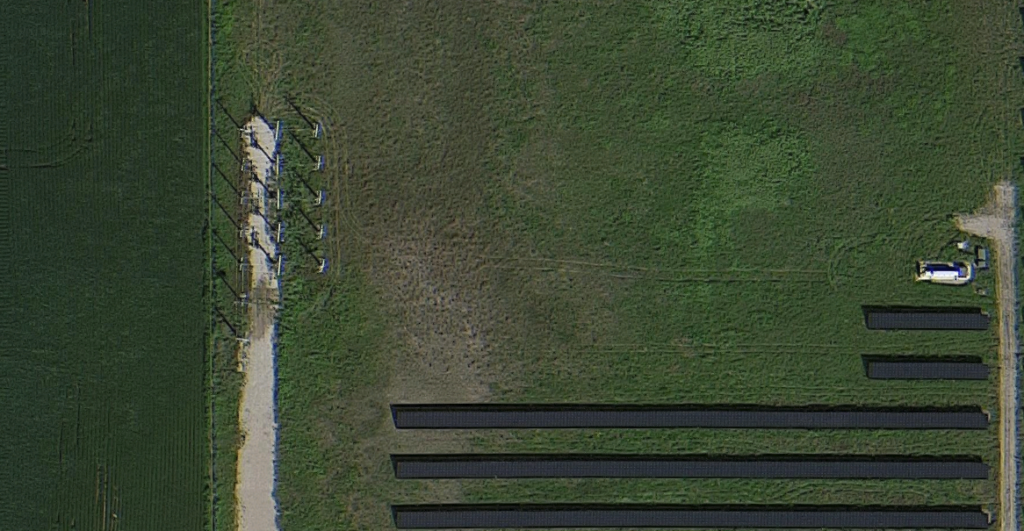Northfield AUAR Comments due soon!
February 22nd, 2023
COMMENTS DUE BY MARCH 2, 2023
Xcel-Northfield-AUAR_Scoping-EAW_20230127
Send comments to Mikayla.Schmidt@ci.northfield.mn.us and Jacob.N.Andre@xcelenergy.com
Xcel Energy is proposing changing land use just north and northwest of Northfield, adjacent to the hospital to the east, and along Hwy 19 on the southeast corner. That Xcel Energy is the proposer is significant, as “Development Scenario A: Technology Center” means a data center that would use LOADS of electricity. “Development Scenario B: Industrial Park” just doesn’t have the same Xcel Energy fingerprints on it, but of course it’s an “alternative.” Data centers use a LOT of electricity, certainly a goal of Xcel.
Remembering all the uproar about rezoning at Co. Rd. 1 adjacent to, on west side of, I-35, which has not been developed, now why this, and why there? With all the residential to the south and east of this AUAR, and the EAW notes that some of the area in question was identified in the “2011 Business and Industrial Master Plan” for “larger-scaled, industrial and corporate office use.” SCAN THE PLAN!
Note that it’s up against the hospital. A data center and industrial park seems a bit different than “industrial and corporate office use.”
Here’s the Scoping EAW from Xcel, with RGU City of Northfield — read it and consider:
What’s to consider? For comments, this is “scoping,” so it’s more of a laundry list of what’s missing, what’s been raised but needs more in-depth info, what’s inconsistent with Northfield’s land use plans, and to comment as specifically as possible. A “NOT HERE” or “I DON”T LIKE THIS” won’t cut it.
What to comment on? As is noted in the AUAR EAW, “Comments should address the accuracy and completeness of information, potential impacts that warrant further investigation and the need for an EIS.”
When I think of a data center, I think of the inherent energy sucking nature and the extreme noise, and I am reminded of the significant drainage and erosion problems in the Wisconsin solar projects — impervious surface of roads, driveways, buildings, that’s a problem (does anyone remember the drainage issues with “Grant Park” and the “Presidential” subdivision by the school?).
Regarding energy use, what’s the transmission and distribution system there? Don’t know !I went out there yesterday to have a look, but it was hard to see in the developing blizzard! Snowplow cam from about half an hour after I went through this intersection:
Couldn’t take decent photos, but a reconnoiter showed that there was no apparent transmission lines in, just a low kV line across the top, along 320th Street. Would that be sufficient? I sent a data request to Xcel and Northfield January 31st, but crickets. in 2002 or so, peak load for Northfield was 35MW or so, and I’d guess now it’s about the same, given efficiency gains over the years and lower demand generally.
See the 2011 Business and INdustrial Park Plan, below for some clues on what’s needed.
Here’s what the area looks like now — corn & beans and beans & corn. Note that there is a small solar array at the center of the upper boundary, and a larger array of solar in the southeast corner:
Water: Drainage, water lines in, sewer and stormwater out… Wasn’t it a $430,000 or so water, sewer, and storm system extension needed for Target, circa 1998, extending the city’s system south, and paid for, subsidized, by the City? What all would be needed and who is paying for it? See that 2011 Plan, linked below.
What would increasing impervious surfaces with roads, driveways, and buildings, do to the drainage in the area? What extent of storm system would be needed, and where would that water go? Storm system, again, see that 2011 Plan…
Traffic is likely an issue, because there’s often backup on Hwy. 19 with the trucks lined up to drop at McLane. Adding industry to the north of Hwy 19 not much further west could add to the backup, and they’d need more room at the Big Steer, eh? Oh, it’s a Flying J now…
How about that energy suck? Where would electricity come from? There is a low kW line paralleling 320th Street, 69kV or maybe just a 34.5kV distribution, to which the small solar field connects, at the intersection here, is new, so I presume it was added for interconnection. Now, what’s to the west?
In the solar project along North Ave (Co. 39) there’s a solar collector substation, but I’ll have to go out again for a drive-by and get photos of the transmission on site and nearby, and of course, read the 2011 Plan:
The 2011 “Business and Industrial Master Plan” specifically addresses many of the issues, i.e., detailed specifics of what would be needed to bring water in to this site, where electricity and gas would come from, etc. Do check it out.
As noticed in the EQB Monitor, January 31, 2023:
Xcel Energy/ City of Northfield AUAR
Location: Northfield, Dakota County
Process: Alternative urban areawide review (AUAR)
Step: Draft order of review
End of comment period: March 2, 2023
Project description: Xcel Energy and the City of Northfield are partnering to conduct an
Alternative Urban Areawide Review (AUAR) for an approximately 787-acre area in the
northwestern portion of the City of Northfield. Portions of the AUAR area include land
within Greenvale Township. Two development scenarios will be evaluated as part of the
AUAR which primarily consist of technology center and industrial park uses. Additional
steps are required to initiate the AUAR process for certain large projects, which include a
public comment period on the scope of the AUAR. This Scoping Document is available for
review and comment as part of the AUAR process in accordance with Minnesota Rules,
part 4410.3610, subpart 5a.
Link to public documents: Excel (sic) Energy / City of Northfield draft order of review
Location of public documents: Northfield City Hall, 801 Washington Street, Northfield, MN 55057
Responsible governmental unit and contact: City of Northfield, Mikayla Schmidt, 507-645-3059
p. 3 of 7 https://www.eqb.state.mn.us/sites/default/files/documents/January%2031%2C%202023.pdf
What to comment on? Again, read it, do a term search for what you’re interested in, and think broadly but in detail. “Comments should address the accuracy and completeness of information, potential impacts that warrant further investigation and the need for an EIS.”
COMMENTS DUE BY MARCH 2, 2023
Send comments to both Northfield, the RGU, and I’d also send to Xcel Energy so they know you’re paying attention:
Once more with feeling, here’s the scoping notice/EAW and proposal:
And again, the 2011 “Business and Industrial Master Plan” — it’s very well done:
From the Business-and-Inustrial-Park-Master-Plan: — is the Xcel Energy proposal consistent with the 2011 Plan? Does the Xcel plan line up with the phasing, and are the steps toward development incorporated into Xcel’s plan?
We could use this level of planning in Red Wing!
Calendars!! MN’s Nitrate rulemaking hearings
May 12th, 2018

There’s a rulemaking afoot, and rulemaking hearing. Usually rulemakings are the not-so-blind leading the blind, because by the time there’s a rule to comment on, the fix is in. It’s been decided how it will go, and the public comment period is just a box to check off. All the action occurs before it is released, the wrangling about language, the focus, all that is done by the agency in consultation with “stakeholders” who are typically the corporate sort that agencies regard as their “constituents” and there’s little public or advocate participation. That’s how it works. If we’re (we the people) are lucky, or if we really push for it, there’s an Advisory Committee, as authorized by Minn. Stat. 14.10:
I don’t see any evidence that it happened here. So… we have a proposed rule, and the comment period is now open, and hearings are being held in various spots in Minnesota.
There’s a hearing now scheduled for Red Wing (links to docs below), which was not in the original list:
Red Wing Nitrate Hearing
Tuesday, June 5
7:00 p.m. – 8:30 p.m.
Minnesota State College Southeast
308 Pioneer Road
Red Wing, MN 55066
Here’s the original schedule:
1:00-6:00 PM on Monday, July 16, 2018
Robert Boeckman Middle School
800 Denmark Ave
Farmington, MN 5502410:00 AM – 4:00 PM on Wednesday, July 18, 2018
Stewartville Civic Center
105 1st St E
Stewartville, MN 5597610:00 AM – 4:00 PM on Thursday, July 19, 2018
Minnesota West Community and Technical College
1450 College Way
Worthington, MN 5618710:00 – 4:00 PM on Wednesday, July 25, 2018
River’s Edge Convention Center
10 Fourth Avenue South
St. Cloud, MN 563019:00 AM – 3:00 PM on Thursday, July 26, 2018
American Legion
900 1st St E
Park Rapids, MN 5670
The “draft” rule has been released for public comment, but there was a first draft rule from June 2017. Below is the official draft, revised in April, 2018:
|
Groundwater Protection Rule (PDF: 328 KB / 26 pages)
Statement of Need and Reasonableness (SONAR) (PDF: 3.18 MB / 164 pages)
Notice of Hearing (PDF: 85 KB / 3 pages)
SONAR Appendixes (PDF: 15.73 MB / 208 pages)
COMMENT PERIOD:
- Initial Comment Period closes on July 31, 2018 at 4:30 p.m
- Rebuttal Comment Period: August 1, 2018 through 4:30 p.m. on August 7, 2018
Here’s where to send comments (note SEND TO OAH, and not Dept. of Ag):
https://mi1111esotaoah.granicusideas.comldiscussio11s/
or
Administrative Law Judge Palmer-Denig
Office of Administrative Hearings
P.O. Box 64620
Saint Paul, Minnesota 55164-0620
There are more specific instructions for filing comments on the OAH site:
Instructions: To comment, scroll down to “Topic: Submit a Comment” and click “View Topic.”Please make sure that your comments:
- Identify the specific part or subpart of the rule you are addressing;
- Specify whether you support or oppose the proposed rule language;
- Give reasons for your views; and
- Be specific and offer language changes to solve the problems you identify.
Attachments: Commenters may attach up to three documents to a comment. Allowed attachments include PDFs, spreadsheets, and word documents. Please include your name and contact information on all attachments.
I can’t stress enough how important it is to be specific, and to refer to parts of the rule that you’re commenting about. Vague rah-rah OR blah, blah, comments will have no impact, nor will form letters or postcards. Once more with feeling, be specific, and to refer to parts of the rule. Have at it!
Criminal Charges Begin re: Flint Water
April 20th, 2016
Yesterday, Alan and I were in Hastings, and we were talking about the extreme pollution of 3M, and of DuPont in Delaware. In Flint, it appears that it’s being taken seriously, though these first three charged may just be the sacrificial offerings:
In Michigan, the dominos are starting to fall. Susan Hedman, former head of EPA Region 5, did the right thing, resigned, and quickly, but since then? Well, now the criminal charges have begun:
Flint water crisis: Criminal charges against three state and city workers
From the article:
I would hope they’ll go deeper and that more will be charged.
It’s different in Minnesota. 3M knew enough to stop manufacturing PFOA, but it was dumped and made its way into our water, there’s a lawsuit initiated by our Minnesota Attorney General, but no criminal charges:
Study finds link between 3M-made chemical and cancer
Lawsuits Charge that 3M Knew About the Dangers of its Chemicals
A few snippets from the above article:
… and (the red links are to EPA testing):
After the initial discovery of PFCs in drinking water near the Cottage Grove plant, 3M installed filtration systems on the water supply for the nearby community of Oakdale, provided bottled water for residents with private wells, and remediated three of its former dump sites. However, the most recent water tests, released by the EPA in January, still showed 25 detections of PFCs in wells that provide drinking water to Woodbury, Oakdale, and Hastings — all of which are near 3M headquarters — as well as in the Cottage Grove water utility, which serves more than 33,000 people.
In two wells in Oakdale, PFOS contamination detected by EPA tests released in January exceeded the provisional health levels set by the agency. And several Oakdale wells had PFOA levels higher than those that qualified residents to participate in a class-action suit against DuPont in West Virginia and Ohio.
The Minnesota Pollution Control Agency has a page on this, where dangers are minimized, and where not much has been posted past 2009 (note landowners with wells have to pay over $300 for testing their water!):
The 3M Cottage Grove Facility and Perfluorochemicals
Why has no one been charged at 3M? Why is this surface and ground water pollution not front and center?
What about the bad water in Pennsylvania from fracking, Dimock, PA comes to mind, and that was public knowledge over 7 years ago:
Gas in wells in Dimock Twp. PA
And remember that National Geographic article with astonishing photos way back in 2007 about the poisoned and dry wells in Wyoming? That was a decade ago. What’s been done?
Drilling in the West – in National Geographic this month












